PRINCETON, NJ -- Along with their mounting concerns about national economic conditions in recent years, Americans have grown more likely to perceive structural economic inequality in the country. Nearly half of Americans, 49%, now say the nation is divided into two groups: the "haves" and the "have-nots." This is up from 45% two years ago, and from 37% in June 2004.
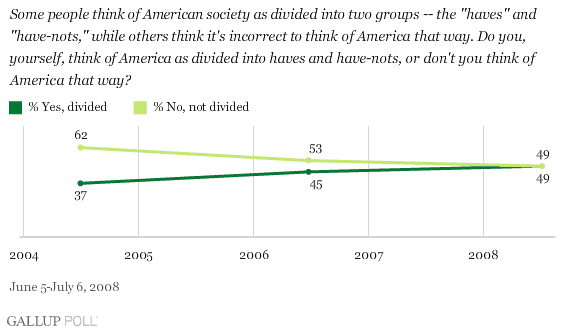
The perception of an unequal society has risen at an especially sharp rate among blacks and Hispanics, although non-Hispanic whites are also more likely to perceive a haves/have-nots division today than they were four years ago. Nearly three-quarters of blacks (72%) and close to half of Hispanics (49%) and whites (45%) now believe the nation is divided along have/have-not lines.
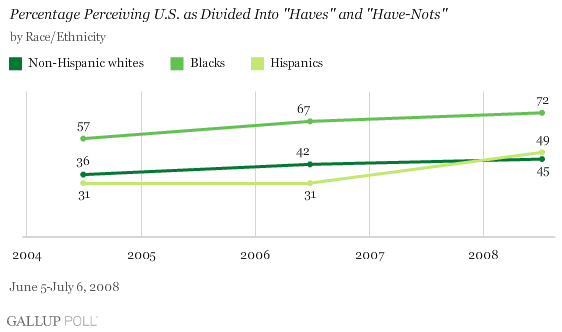
These results are from Gallup's annual Minority Rights and Relations survey, conducted each June. The 2008 survey includes nationally representative interviews with 1,935 adults, including more than 700 non-Hispanic whites, more than 600 blacks, and more than 500 Hispanics, all weighted to represent their correct proportions in the population.
At the same time that more Americans see an economic class divide in the country, the percentage of Americans holding a profoundly negative view of the U.S. economy has jumped sharply, from 41% in June 2004 to 55% in June 2006 to 84% in June 2008.
Majority Still Identify Themselves as "Haves"
Despite their heightened sense that America is a land of the haves and have-nots, Americans have not changed the way they categorize themselves along the same lines. Since 2004, the percentage of Americans identifying themselves as a member of the "haves" in Gallup polling has registered just under 60%, while about a third have consistently considered themselves "have-nots." (An additional 8% to 12% don't put themselves in either group.)
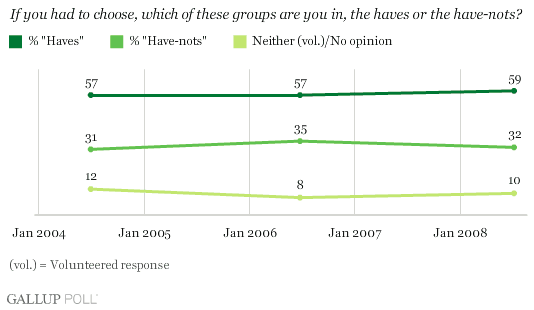
There are no meaningful differences among Americans of different household income levels in their perceptions of whether the country is divided into the haves and have-nots. High-, medium-, and low-income groups are all about evenly split on the question.
However, as expected, there is a high correlation between self-identification as a have or have-not and one's household income. About three-quarters of high-income Americans (those making $75,000 or more annually) call themselves "haves," compared with a much smaller majority of middle-income households (those earning between $30,000 and $50,000), and only 33% of the lowest income group (those making less than $20,000).
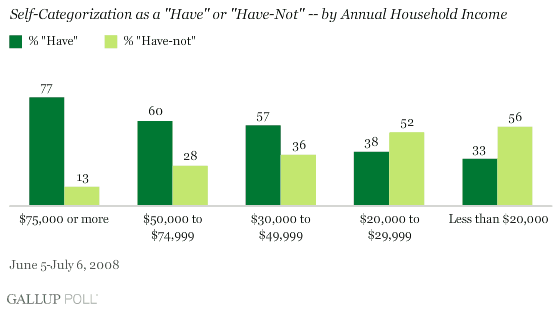
Non-Hispanic whites are more than twice as likely to call themselves haves as have-nots (64% vs. 26%). This contrasts with blacks and Hispanics, who are about evenly divided in their self-descriptions. None of these findings by race/ethnicity has changed much in recent years.

Perhaps most interesting is that even at comparable income levels, middle- and upper-income blacks and Hispanics are less likely than whites to consider themselves "haves."
-
Among those earning between $30,000 and $74,999 per year, 63% of whites, but only 48% of blacks and 47% of Hispanics, classify themselves as "haves."
-
Similarly, among those earning $75,000 or more, fully 80% of whites, compared with 66% of blacks and 65% of Hispanics, call themselves "haves."
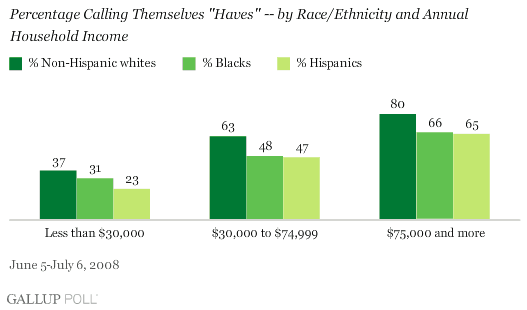
Implications
The fact that recent economic events -- such as the mortgage crisis, surging energy prices, and rising food costs -- are hitting some Americans harder than others may partly explain why more Americans in 2008 than four years ago believe the nation is divided into the haves and the have-nots.
But economics may not tell the whole story. Blacks and Hispanics -- even those living in high-income households -- lag significantly behind whites in believing they are among the nation's "haves." Beyond financial issues, these groups may be more likely today than four years ago to perceive that certain obstacles stand in the way of members of their own racial and ethnic groups' ability to break into the advantaged class.
Survey Methods
Results are based on telephone interviews with 1,935 national adults, aged 18 and older, conducted June 5-July 6, 2008, including oversamples of blacks and Hispanics that are weighted to reflect their proportions in the general population. For results based on the total sample of national adults, one can say with 95% confidence that the maximum margin of sampling error is ±4 percentage points.
For results based on sample of 702 non-Hispanic whites, the maximum margin of sampling error is ±5 percentage points.
For results based on sample of 608 non-Hispanic blacks, the maximum margin of sampling error is ±5 percentage points.
For results based on sample of 502 Hispanics, the maximum margin of sampling error is ±6 percentage points (120 out of the 502 interviews with Hispanics were conducted in Spanish).
Interviews are conducted with respondents on land-line telephones (for respondents with a land-line telephone) and cellular phones (for respondents who are cell-phone only).
In addition to sampling error, question wording and practical difficulties in conducting surveys can introduce error or bias into the findings of public opinion polls.
To provide feedback or suggestions about how to improve Gallup.com, please e-mail feedback@gallup.com.
